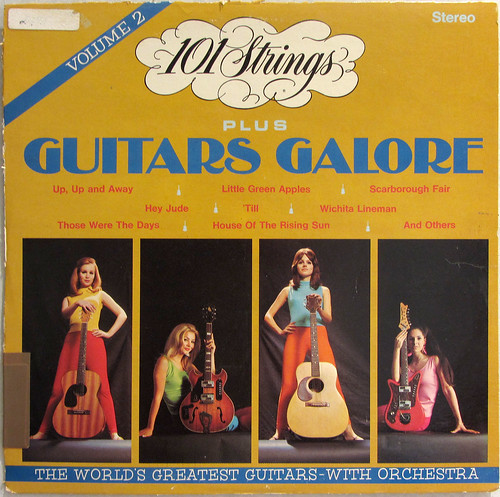A lot of people today think of 101 Strings as a generic easy-listening franchise that appealed only to casual music buyers who had no taste, but some of the 101 Strings records were very popular with all age groups. Believe it or not, Dick Clark featured the 101 Strings album Back Beat Symphony on American Bandstand in 1961, and within a month, the single from the album had sold over 400,000 copies. In 10 years, the ensemble sold 50,000,000 records.
Although 101 Strings released countless albums of movie themes and romantic themes, its vast discography also includes some oddball albums, many of which seem likely to have alienated the average 101 Strings listener. Today on Music Weird, we'll look at some of the best and weirdest albums of the 101 Strings.
Back Beat Symphony (1961)
The album Back Beat Symphony was one of several attempts around that time to combine light classical and traditional orchestral pop music with rock 'n' roll rhythms. Other examples include Ray Conniff's Concert in Rhythm (1958) and Ray Martin's Rockin' Strings (1961).
Back Beat Symphony was reissued in its entirety on the CD Rock & Roll Symphony No. 1: A 1959 Stereo Concert.
Sounds and Songs of the Jet Set (1965)
Sounds and Songs of the Jet Set is another one of 101 Strings' sporadic rock-oriented efforts. The snazzy illustrated cover looks like something out of a travel magazine, and the theme of travel continues halfheartedly throughout the track list. Although most of the album's musical destinations are Latinesque, such as "Puerto Vallarta" and "Bahia de Acapulco," others seem random, like "A Hard Day's Night." Musically, it's pretty bombastic for a 101 Strings album, especially "Cantina Tarosa." Here is the album's "Killer Joe a Go-Go":
Plus Guitars Galore (1966) and Plus Guitars Galore Volume 2 (1969)
The two Guitars Galore albums are among my favorite 101 Strings albums. They both prominently feature guitars on arrangements of contemporary selections such as the Beatles' "Hey Jude" and Chris Montez's "Call Me." Alshire Records reissued Guitars Galore on CD in the 1980s.
Sounds of Today (1967)
Sounds of Today has one of the best album covers of all the 101 Strings albums. The music isn't quite as psychedelic as the cover art, but it has its moments. Some of the notable original cuts—"Karma Sitar," "Blues for the Guru," and "Strings of Ravi"—appeared on several subsequent 101 Strings albums.
Astro-Sounds from Beyond the Year 2000 (1968)
One of the few 101 Strings albums that has been reissued by a label other than Alshire or Madacy, Astro-Sounds from Beyond the Year 2000 is definitely one of the ensemble's weirdest efforts. Really, only the Sounds of Love albums rival it. You know that you're in for something different from the average 101 Strings album when you see titles like "Re-entry to Mog," "Astral Freakout," and "Barrier X-69."
The album rocks pretty hard with fuzz guitar and synthesizers. It was reissued on CD by Scamp Records in 2009 and was fetching high prices for a while, but now you can get it for cheap as a print-on-demand CD-R on Amazon. The CD includes a few bonus tracks from the 1970 album Exotic Sounds of Love.
Plays Hits Written by the Beatles (1968)
This is one of the more collectable 101 Strings albums, because of the Beatles connection. "Hard Day's Night," which appeared on the album Songs and Sounds of the Jet Set, reappears here. True to form, 101 Strings slip in a few cuts that aren't Beatles songs at all: "Blues for the Guru" (from Sounds of Today) "Six Pence and You," and "Tropic of Chelsea."
Monty Kelly, one of the staff arrangers for 101 Strings, wrote "Blues for the Guru" as well as many of the other original 101 Strings compilations that crept into otherwise thematic collections like this one.
The Sounds of Love (1969) and The Exotic Sounds of Love (1970)
The Sounds of Love and The Exotic Sounds of Love were two of 101 Strings' forays into the realm of erotic music. They aren't the only examples of risque content on 101 Strings albums, though; a couple of 101 Strings albums even had photographs of nude women on the cover.
The Exotic Sounds of Love is better than The Sounds of Love. It contain some tracks from Sounds of Today with the addition of a woman's orgasmic moaning, similar to Jane Birkin and Serge Gainsbourg's "Je t'aime... moi non plus," which was a huge international hit in 1969 and certainly inspired these two 101 Strings albums. On Sounds of Love, some guy recites bad poetry between the orchestral instrumentals. The Exotic Sounds of Love is much harder to find than The Sounds of Love. And what's going on in that cover photo?
Polkas (1971)
Symphonic polka is an underexplored genre of music. This 1972 album was also released on 8-track tape.
Swingin' Songs (1972)
101 Strings' quadraphonic album.
Journey into Space (1979)
Features the themes from Star Wars, Superman, and Battlestar Galactica along with space-themed cuts like "Uranus" and "Memories of Venus."
Plus Plus Plus (1986)
This CD on Alshire Records doesn't appear to have had a vinyl counterpart. It is a collection of rock-oriented songs from earlier 101 Strings albums, many of which appear on this list: "Hey Jude," "Karma Sitar" (without the orgasmic moaning), "Killer Joe," etc.






















